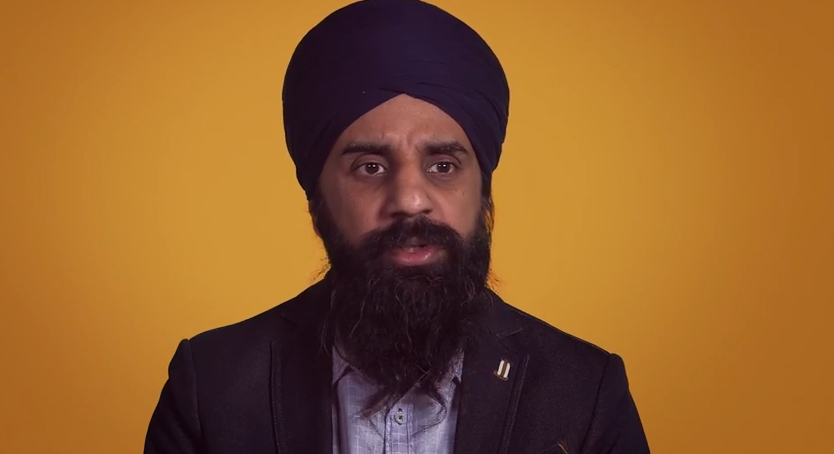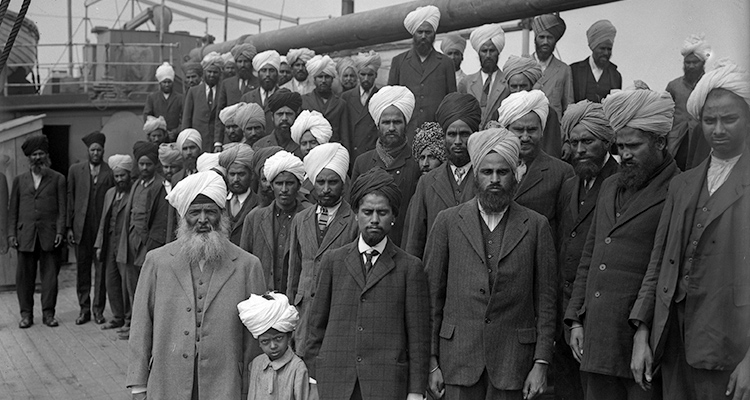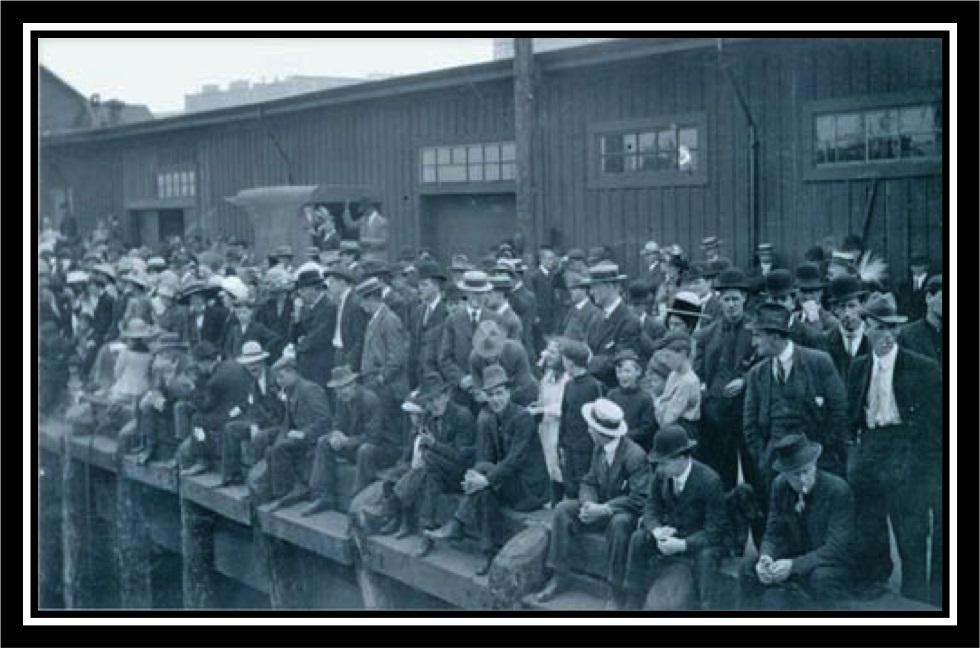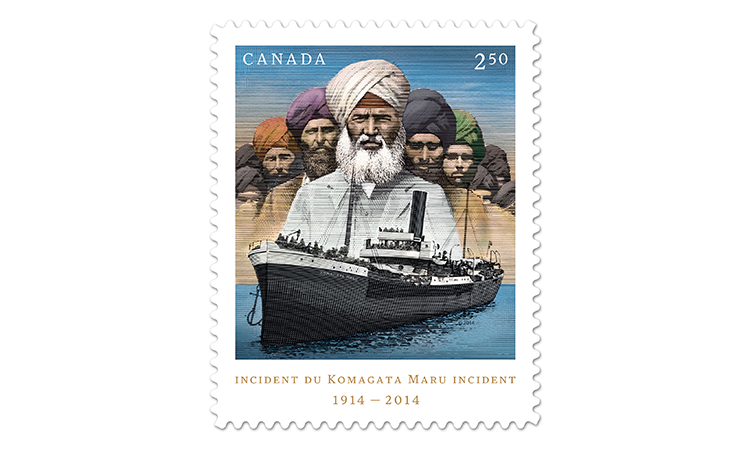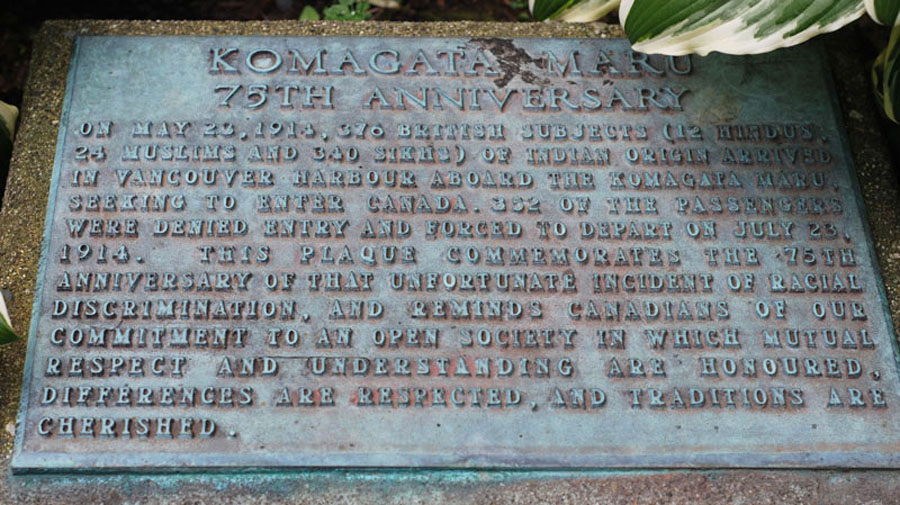Educator Tools

 Ask yourself:
Ask yourself:
- How do prejudice and discrimination prevent immigration for those who are seeking asylum?
- What laws are in place to protect the rights of immigrants?
This really happened
The Komagata Maru was a Japanese steamship that sailed from Punjab, India to Vancouver, British Columbia in 1914, via China and Japan. Upon arrival to Canada, entry was denied for all the ship’s Indian passengers who were hoping to immigrate. A law stated that those hoping to immigrate could only do so by a continuous journey and through tickets purchased before leaving their country of nationality. Because of these exclusionary laws designed to keep out immigrants of Asian origin, the ship was forced to return to India. Upon arrival in India, a riot broke out, killing about 20 passengers who were thought to be lawbreakers and political agitators.
By investigating photographs, reading about voices connected to the incident, exploring a script and discussing whether apologizing is enough, you will consider how the media has an impact on historical events as well as investigate laws connected to immigration that might be discriminatory.
 Artifacts
Artifacts
There are many existing archival photos of the Komagata Maru incident. Many photos featured in newspaper articles give insight into the experiences of the people involved. The two pictures depict a moment on board the ship and on the pier in Burrard Inlet, Vancouver. Together these images convey two different perspectives providing insights into the thoughts and feelings of both groups of people involved.
ACTION 1
Do
Response to images
A. Work in four large groups to examine these photos. To begin, two groups can examine Photo A, and two groups can work with Photo B. As a group, share your responses to this image by considering the following areas of inquiry. Use a T-chart format to organize your thoughts.
| What do you see? | What do you wonder about? |
B. As a group, recreate the photo of some of the people in the scene. Each person will need to choose one character’s role to play. What physical position will you take? What gestures and facial expressions will you include?
C. Once each group has prepared the still image, Group A1 can stand opposite a partner Group A1 (i.e. both still images face each other on a count of three.)
The activity is then repeated, with one group being an audience for the other. Those who are watching the image are encouraged to walk around the image to examine it from a variety of angles and to look carefully at the gestures and facial expressions. On a piece of chart paper, with markers, record what comes to mind when you look at the picture: What did these people feel like? What might these people say? What words convey their emotions?
Each group should have the opportunity to present images to their partner group and complete the chart.
Discuss
As a class, discuss the following:
- What did you learn about the Komagata Maru incident from looking at the photos?
- What stories do pictures tell?
- Can one picture capture a truth?
- Why were the people on the pier so fearful of approaching immigrants?
- What other pictures might you expect to see?
ACTION 2
Do
The Komagata Maru Incident: The Script
Sharon Pollock, Canadian playwright, wrote a play entitled The Komagata Maru Incident. It depicts historical events that invite readers and audiences to ask questions about the real story and the one depicted on stage. The following scene takes place early in the script. T. S., The Master of Ceremonies, who plays many roles, meets with immigration inspector, William Hopkinson.
A. Reading and responding to the script excerpt
Read the script independently, then work with a partner to discuss the following:
- What are some facts you learn from this excerpt about the plight of the Sikhs aboard the ship?
- Summarize the two points of view of these characters.
- In the play, the character of T. S. plays the Master of Ceremonies (and other roles). What role do you think T. S. is playing here? How might you describe this character?
- How do you imagine that this scene might be staged for a theatre presentation?
B. Interpreting the script
With a partner, choose a role to read aloud from this script. Repeat the activity, switching roles.
To rehearse this script, actors might play their roles in different ways. Once you have decided upon a role to practice, choose one of these attitudes/emotions to interpret the lines (e.g., T. S. could be calm and Hopkinson could be angry; both characters could be angry, etc.).
- calmly
- with anger
- with hesitation
- with sadness
- apathetic, uncaring
C. Rehearsing the script
As an actor rehearses, he or she explores a variety of emotions to inform how to best convey the meaning of the texts. Experiment with a few different ways to read these lines with your partner. Discuss which way seemed the most authentic theatre presentation (i.e., how would each character feel as they continue the conversation?). Once you have rehearsed the scene, present it to another pair and compare different interpretations.
ACTION 3
Do
Writing a new scene
A. As with any historical conflict, there are many sides to the story. Choose one or more of the following roles to write a new scene that features two or three characters. Choose roles from any combination of the following:
- An immigration official
- A Sikh who has travelled aboard the ship
- An Indo-Canadian who has been living in British Columbia for several years
- The Prime Minister of Canada
- A politician who demands that entry be denied
- Others?
B. In pairs, or small groups, prepare a new scripted scene to convey other viewpoints connected to this event. For this scene, consider:
- Which characters might appear in the scene?
- What is the setting?
- How will the particular conflict be conveyed?
- What information and feelings will your scene represent about the injustice done to immigrants?
C. Once completed, rehearse the scene with your group to present to others who have worked on a different scene.
Note: The complete Sharon Pollock script of The Komagata Maru Incident is available through Playwrights Canada Press.
The Komagata Maru Incident: A script by Sharon Pollock
|
|
|---|---|
| T. S.: Master of Ceremonies William Hopkinson: Department of Immigration Inspector |
|
| T.S. | The Komagata Maru’s in port with three hundred and seventy-six potential immigrants. |
| Hopkinson: | Yes, sir. |
| T.S. | So? What do you know about them? |
| Hopkinson: | I’ve spoken to my man, Bella Singh, sir. He tells me they’re Sikhs from India, British subjects, and as such they do have a right of entry to Canada, sir. |
| T.S. | The word is no entry. |
| Hopkinson: | I realize that, but we may have a problem. |
| T.S. | A what? |
| Hopkinson: | Many are veterans of the British Army, sir: they’re sure to plead consideration for military service. |
| T.S. | You can put it this way—we don’t mind them dying for us, we just don’t want them living with us. (laughing.) Get the point. |
| Hopkinson: | (laughing) Yes sir… but if they should go to the courts |
| T.S. | They won’t go to the courts. He hasn’t done his homework. Have you forgotten our two orders-in-council? If an immigrant wishes to enter the country through a western port, he must make a continuous voyage from his own country. Have they done so? |
| Hopkinson: | No sir, they haven’t. |
| T.S. | And that’s no surprise. There’s not a steamship line in existence with a direct India-to-China route and for our second ace-in-the-hole – a tax, two hundred dollars per head, to be paid before entry. Do they have it? |
| Hopkinson: | Bella Singh says they do not, however |
| T.S. | Again, not surprising. In the land of his birth, the average Indian’s wage is nine dollars per year. There—you see how we operate, Hopkinson? Never a mention of race, colour, or creed – and yet, we allow British subjects; we don’t allow them to enter. |
| Hopkinson: | Thank you, sir; However, I must inform you that Herman Singh says |
| T.S. | Sh, sh. |
| Hopkinson: | (lowering his voice) Hermann Singh says that the local Sikhs have raised the money for the head tax. |
| T.S. | That’s not good. |
| Hopkinson: | It’s possible that a launch |
| T.S. | It is possible? Do you pay for information like that? |
| Hopkinson: | Bella Singh says a launch will deliver the head tax to those on ship late tonight. |
| T.S. | The word is no entry, Hopkinson. |
| Hopkinson: | Yes, sir! |
*Note: B. Singh was an active member of the Shore Committee members, an Indian community in British Columbia
ACTION 4
Think
Voices of the Komagata Maru Incident: Entry Denied
Imagine the ship docked in the Vancouver Harbour in the warm summer months of June and July with 376 passengers ready to disembark; ready to begin a new life in Canada only to be told their entry was denied. They would not be able to leave the ship: no food, no water, and no communication with the outside world. Their hopes and dreams of working in Canada, beginning a new life, sending for their loved ones were lost.
On the other side of the dock were government officials, lawmakers, citizens who faced their own struggles. Would these workers take their jobs? Would many more follow? Were they different because they were Indian? Would they change their way of life?
For two months, Canadians, including members of the South Asian community, rallied to give entry to the passengers in the media, in the public eye, and in the courts. They fought racist thinking and values and they fought racist laws designed to keep Asians out of the country.
Other Canadians fought to preserve what they believed their borders guaranteed them. They thought they were fighting for their jobs and way of life.
Discuss
- Do you think the government or the immigrants had a stronger argument?
- How do you think the media might have captured the event?
- How does the Komagata Maru incident serve our understanding of prejudice and discrimination?
- Research how Canadian immigration policy has changed since 1914 and make a list of the changes that might serve to prevent an incident like this from happening again.
- Even though the law has changed, do you know of any situations today that might echo the sentiments of the above quotations and perspectives?
ACTION 5
Discuss
Is Apologizing Enough?
A. With a partner, discuss what an apology means to you. Remember and share a significant experience where you (or someone you know) apologized to someone or when you received an apology. Consider:
- How did you feel after giving or receiving an apology?
- Do you think the apology was sincere?
- Did the apology change your relationship with that person?
- What might have happened had you not apologized?
- Did your apology include more than words?
B. In a class discussion, consider the criteria for a strong and meaningful apology. You may volunteer to share personal stories about apologies.
A Country Apologizes
Considering the criteria you generated for a personal apology, does this criteria apply to a country apologizing for an injustice to a group of people?
- In 2008, the British Columbia government brought forth a motion of apology in the Legislative Assembly. Read the motion and discuss if this apology is meaningful and meets your criteria for an apology. Why do you think it took so long for this apology to be granted?
Debates of the Legislative Assembly
2008 Legislative Session:
4th Session, 38th Parliament, Friday, May 23, 2008
B.C. Government, Motion No. 62 – Motion of Apology
Komagata Maru: Motion Unanimously Approved
“Be it resolved that this Legislature apologizes for the events of May 23, 1914, when 376 passengers of the Komagata Maru, stationed off Vancouver harbour, were denied entry by Canada. The House deeply regrets that the passengers who sought refuge in our country and our province, were turned away without benefit of the fair and impartial treatment befitting a society where people of all cultures are welcomed and accepted.”
- In August, 2008, at the Bear Creek Park in Surrey, British Columbia, Prime Minister Stephen Harper spoke in front of 8,000 people at an East Indian Canadian community event to offer a federal apology for the 1914 Komagata Maru incident. Read the apology and consider the strength of Harper’s words:
- Would this be enough for a community that felt this injustice from the past?
- What message might Harper have added to his speech to convince others of the government’s sincerity?
- Members of the Descendants of the Komagata Maru Society immediately following the speech rushed to the podium denouncing the apology.
- Why might they have responded this way?
- What else could the Canadian government have offered by way of apology?
In May 2016, Prime Minister Justin Trudeau issued a formal apology for the Komagata Maru in the House of Commons: “No words can fully erase the suffering of the Komagata Maru victims. Today we apologize and commit to doing better.” Canadian Sikhs have become a significant political force with Jagmeet Singh being elected the first Sikh and first South Asian leader of a national party, the New Democratic Party (NDP), in October 2017.
ACTION 6
Think
Apologies have been made to other groups who have faced injustices in both immigrating and settling in this country (e.g., the Chinese Head Tax, the internment of Japanese Canadians during World War II, and others.)
- Are there groups of people today emigrating or settling in Canada who continue to face injustices?
- How could we or the government support these groups?
Further reading:
Ali Kazimi, Undesirables: White Canada and The Komagata Maru. An Illustrated History (Toronto: Douglas and McIntyre, 2012). This book documents the incident using archival photos, personal stories, and historical references to the immigration of the Indo-Canadian community.
Every effort has been made to gain permission from copyright holders to reproduce borrowed material. The publishers apologize for any errors and will be pleased to rectify them in subsequent reprints and website programming
Educator Tools


